When you start comparing electric scooter models, it's easy to get lost in the numbers. But honestly, it all boils down to a few key things that actually define your ride. The big three are real-world range (how far you can actually go), motor power (for speed and hills), and the braking system (your main safety net). If you nail these three, you'll cut right through the marketing noise.
Decoding the Specs That Actually Matter
Feeling overwhelmed by a wall of technical jargon? You're not alone. Manufacturers love to flash impressive-sounding numbers, but a lot of it is just fluff. Let's skip the hype and focus on a simple way to evaluate the specs that will genuinely impact your daily rides.
We'll translate these numbers into what they mean for real-world performance, whether you're zipping through busy US city streets or cruising along a scenic Australian bike path.
This quick snapshot gives you a good idea of what to expect from most entry-level to mid-range electric scooters in terms of performance and price.
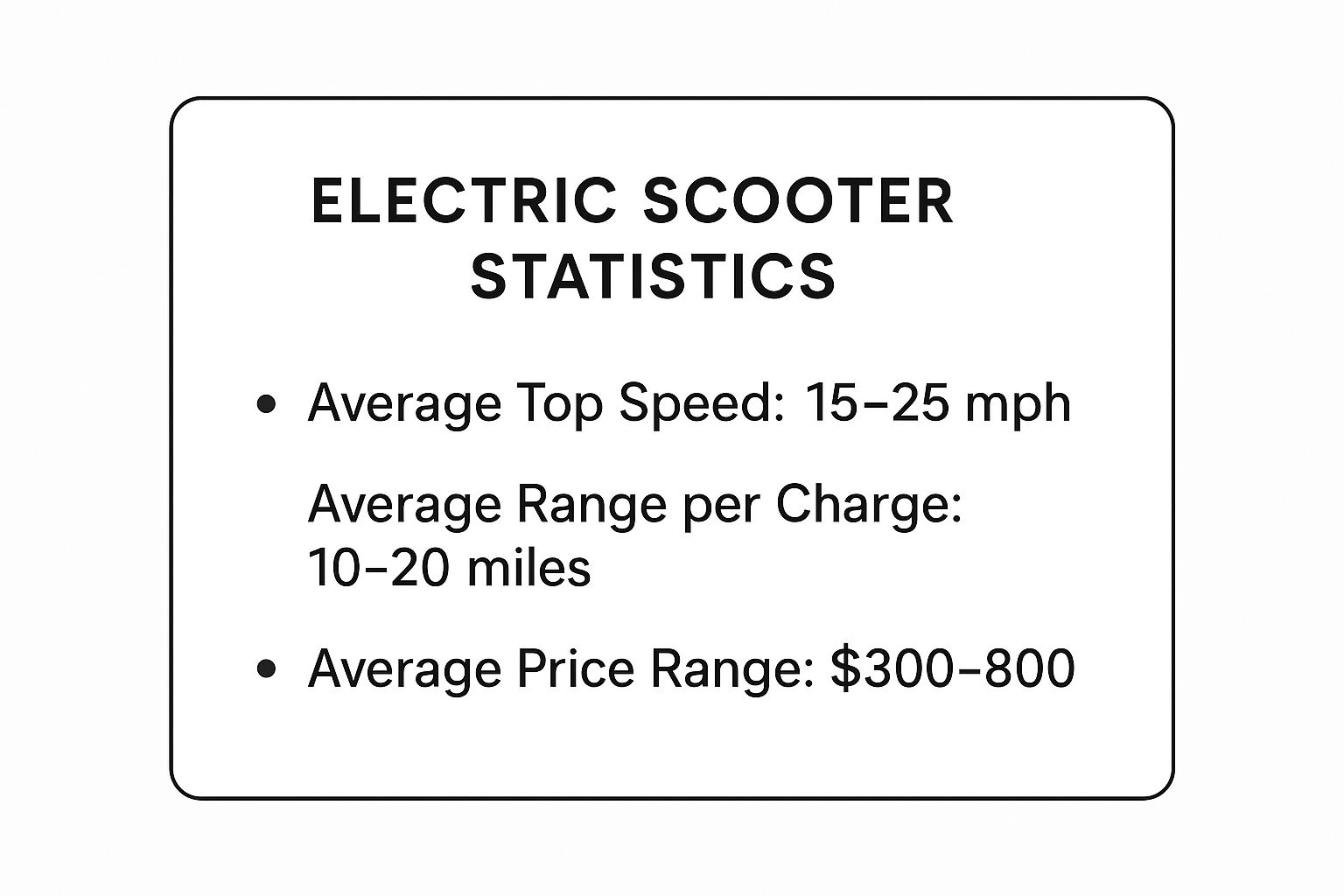
As you can see, a budget of around $400-$800 will get you a solid scooter that can handle most urban commutes with plenty of speed and range for your day-to-day needs.
Key Performance Indicators at a Glance
Alright, let's break down the most critical specs you should be looking at. This table gives you a quick summary of what matters most and helps you understand the trade-offs between different models.
| Specification | What It Means for Your Ride | Ideal for US/AU Commuters | Ideal for Casual Use |
|---|---|---|---|
| Real-World Range | The actual distance you'll get on a single charge. This gets hit hard by hills, your weight, and how fast you ride. | 15+ miles (24+ km) | 10-15 miles (16-24 km) |
| Motor Wattage | This is all about acceleration and tackling inclines. More watts equals more grunt. | 350W+ | 250W–350W |
| Brake Type | Your number one safety feature. Disc brakes give you the best, most reliable stopping power, period. | Dual Brakes (Disc + Electric) | Single Brake (Disc or Drum) |
| Tyre Type | This dictates ride comfort and how much maintenance you'll be doing. Pneumatic (air-filled) tyres are way smoother. | 10-inch Pneumatic | 8.5-inch Solid or Pneumatic |
By the time we're done here, you’ll be able to glance at any scooter's spec sheet and know exactly what it means for you. That's the key to making a smarter purchase you won't regret.
Comparing Real-World Range and Battery Health
Let's be honest: the range printed on the box is almost never what you'll actually get. Scooter brands test their models under ridiculously perfect conditions—think a super lightweight rider on a perfectly flat, smooth track with zero wind. When you're trying to pick a scooter, you have to look past that best-case number and get a feel for what really affects battery performance out on the street.
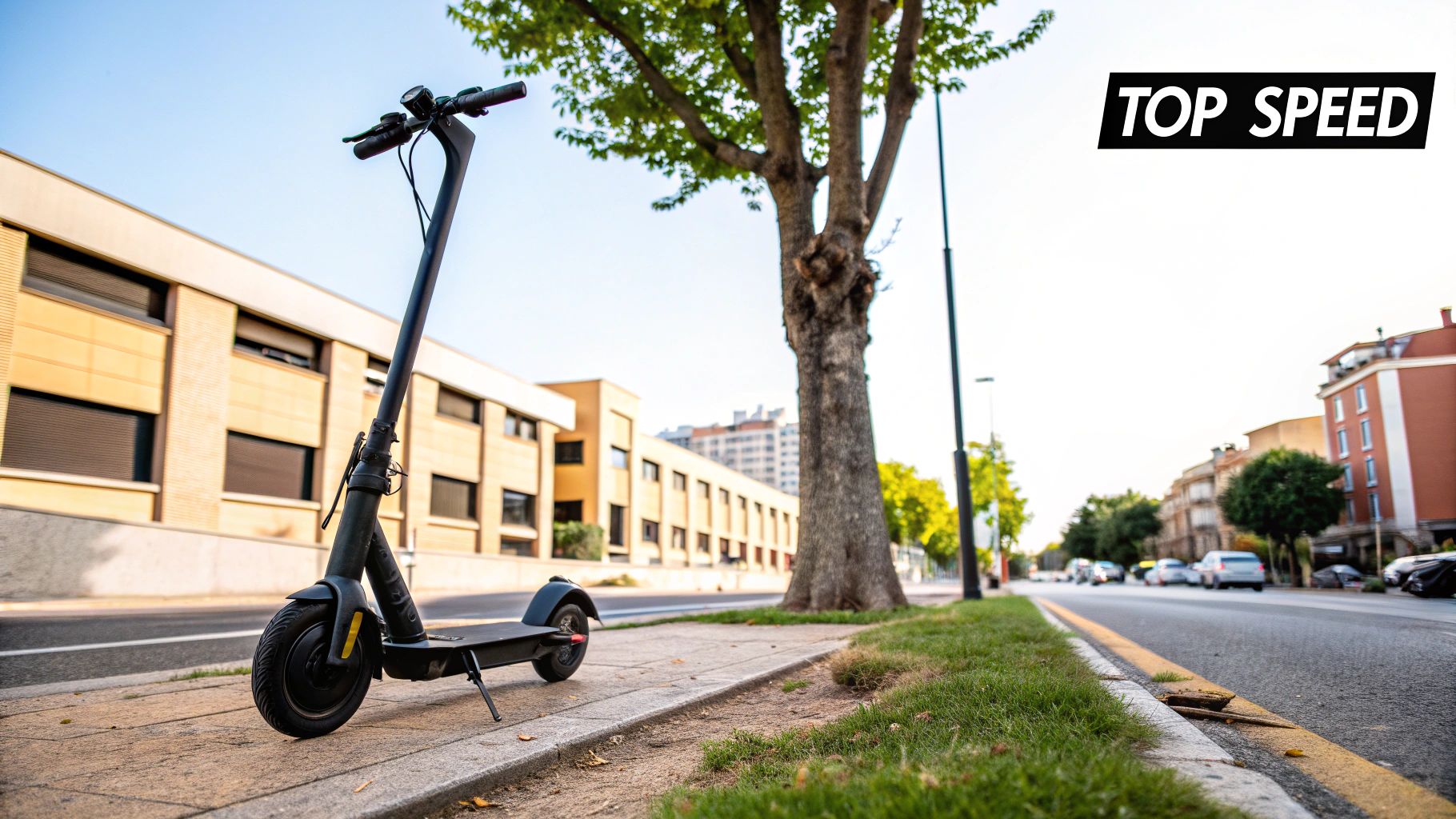
Treat the advertised range as a starting point, nothing more. Your real mileage gets chipped away by things like your own weight, the hills on your commute, and even the weather. For instance, cold can slash a battery's capacity by up to 20-30%. That's a huge drop, especially for riders in colder US states facing a chilly winter.
What Determines True Battery Performance
The biggest piece of the puzzle is the battery tech itself. The market has changed a lot. Early e-scooters often had clunky lead-acid batteries with serious limitations. Thankfully, since about 2020, the industry has almost completely switched over to lithium-ion (Li-ion) batteries. They just perform better, last longer, and give you more bang for your buck over the scooter's lifetime. You can learn more about this industry trend and how it’s shaped the scooters we see today.
But it’s not just about the battery cells. The unsung hero is the Battery Management System (BMS). This little onboard computer is an absolute must-have for keeping your scooter safe and your battery healthy.
A good BMS is constantly working behind the scenes to prevent disaster:
- Preventing Overcharging: It cuts the power once you hit 100%, stopping any damage.
- Stopping Over-Discharging: It shuts things down before the battery is totally empty, which can kill it for good.
- Balancing Cells: It makes sure all the individual cells in the battery pack charge and drain evenly, which is key to a long life.
- Managing Temperature: It keeps an eye out for overheating and can shut the scooter off to prevent a fire.
A scooter with a cheap, shoddy BMS isn't a bargain; it's a liability. You'll face a much shorter battery life and, more importantly, a serious safety risk. Stick with reputable brands that don't cut corners on their battery components.
How to Estimate Your Real-World Range
So, how can you ballpark the range you'll actually get? A solid rule of thumb is to take the manufacturer's number and knock off about 30-40%. That'll give you a much more realistic figure. For a scooter advertised with a 20-mile range, you should expect to get somewhere around 12-14 miles in a typical US or Australian city.
Think about your daily ride. If it's full of steep hills, you'll burn through the battery way faster. You'll need a scooter with a bigger battery capacity (measured in Watt-hours or Wh) to handle that extra drain. Moving up from a standard 280Wh model to one with a 360Wh battery will make a real difference, giving you peace of mind that you won't be pushing your scooter home.
Motor Power and Hill Climbing Capability
Let's talk about the engine of your scooter: the motor. This is what gives your ride its personality. It determines how fast you take off from a standstill and, more importantly, whether you’ll conquer that beast of a hill on your way to work or have to do the walk of shame.
If you live in a particularly hilly area, like San Francisco or the suburbs of Sydney, the motor’s performance is something you absolutely can't ignore. A weak motor can turn a minor incline into a major roadblock.
When you start browsing for scooters, you'll see two power ratings thrown around: nominal and peak wattage. Nominal power (like 350W) is the steady, continuous power the motor puts out without breaking a sweat. Peak power is that short burst of oomph it gives you for takeoffs or tackling a steep climb. You need a good mix of both.
A simple way to think about it: Nominal power is your cruising speed on a long, flat road. Peak power is the extra gear you kick into when you need to overtake someone or start up a hill.
Finding the Right Motor for Your Commute
So, how much power do you actually need? For most people riding on mostly flat ground, a scooter with a 350W nominal motor will feel plenty zippy. It’s more than enough for getting around town and handling gentle slopes without any drama.
But if your daily route involves the kind of hills you find in places like Seattle or Brisbane, that 350W motor is going to feel underpowered. You'll notice it slowing down, and the ride can feel like a real struggle.
That's where a jump to a 500W motor really pays off. The difference is night and day. That extra power gives you the torque needed to climb hills confidently, letting you keep your speed up when other scooters are slowing to a crawl.
For those who refuse to compromise—or for heavier riders and people in seriously hilly areas—a dual-motor scooter is the ultimate solution. With a motor in both wheels, you’re often looking at a combined peak power of 1000W or more. The power is just on another level.
Here’s what that looks like in the real world:
- 350W Motor: Expect it to slow to under 10 mph on a decent 10% grade hill.
- 500W Motor: You’ll comfortably hold 12-15 mph on that same incline.
- Dual-Motor (1000W+): It’ll feel like the hill is barely there, often climbing close to top speed.
The key isn't just to buy the most powerful scooter you can find. It’s about being honest about the terrain you’ll be riding on. Match the motor to your environment, and you’ll end up with a scooter that feels just right, every single time.
Ride Quality: Suspension, Brakes, and Tyres
A beefy motor and a long-range battery look great on a spec sheet, but they don't mean much if the ride rattles your bones or you can't stop on a dime. When you're really comparing electric scooters, you have to look at the parts that give you a smooth, controlled, and—most importantly—safe ride. These components are the unsung heroes of your daily commute.
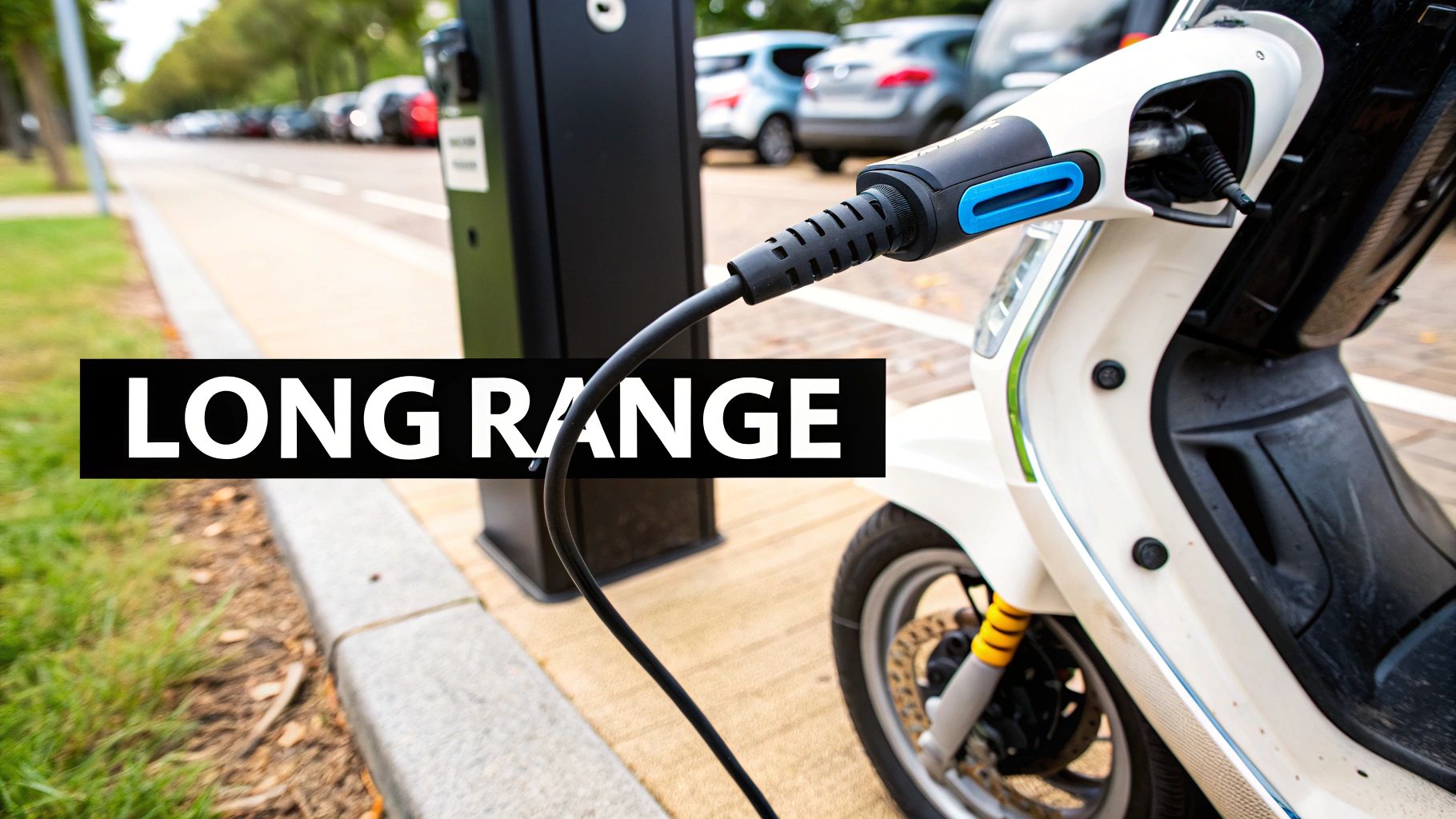
It's the combination of suspension, brakes, and tyres that turns a scooter from a fun gimmick into a serious vehicle. Let's dig into what really matters for each one.
Smoothing Out The Bumps With Suspension
Suspension is your number one defense against rough city pavements and pothole-ridden roads. Without it, you’ll feel every single crack and bump shooting right up through your arms and legs. Trust me, if you're riding for more than a few minutes a day, it’s an absolute game-changer.
You'll generally come across a few different types:
- Spring Suspension: This is the most common setup and for good reason—it's effective and doesn't break the bank. A simple coil spring absorbs the worst of the impacts and is a huge step up from no suspension at all.
- Hydraulic Suspension: Found on higher-end models, this system uses oil-damped shocks, much like a mountain bike. The result is a far smoother, more controlled ride that glides over bumps instead of just bouncing on them.
- Rubber Suspension: Some scooters use dense rubber blocks to soak up vibrations. It’s decent for small chatter but can feel a bit stiff when you hit bigger obstacles.
For most city commuters, a dual-spring suspension system hits the sweet spot between comfort and cost. But if your daily route feels more like an off-road track, splurging on a scooter with hydraulic suspension will make an incredible difference to your ride quality.
Why You Can't Skimp On Brakes
Let's be blunt: your ability to stop quickly is the most important safety feature on your scooter. When a car pulls out in front of you, you need brakes you can count on without a second thought.
Never, ever compromise on braking power. A scooter's stopping distance is directly tied to your safety. Spending a little extra on a model with better brakes is a smart investment in your own well-being.
Before we get into the details, here’s a quick table to make sense of the trade-offs you’ll be making when it comes to ride comfort and safety.
Ride Comfort and Safety Feature Comparison
| Component | Option A (e.g., Solid Tyres) | Option B (e.g., Pneumatic Tyres) | Best For This Rider |
|---|---|---|---|
| Brakes | Mechanical Disc Brakes | Drum Brakes | Disc brakes are for riders who need top-tier, reliable stopping power in any weather. |
| Tyres | Solid Rubber Tyres | Pneumatic (Air-Filled) Tyres | Pneumatic tyres are for anyone who puts a premium on ride comfort over zero maintenance. |
| Suspension | Spring Suspension | No Suspension | Spring suspension is a must-have for anyone commuting regularly on imperfect city streets. |
The key takeaway here is that disc brakes provide the best all-around performance, giving you powerful, consistent stopping in both wet and dry conditions. Drum brakes, on the other hand, are sealed inside the wheel hub, which means they need less maintenance but offer slightly less bite.
Many scooters also have regenerative braking, which uses the motor's resistance to slow you down while feeding a tiny bit of energy back to the battery. It's a nice feature to have, but it should always be a backup, not your primary stopping system. Getting a feel for your brakes is a crucial part of learning how to ride an electric scooter safely.
The Big Tyre Trade-Off: Convenience vs. Comfort
Finally, we get to tyres. Your choice is almost always between solid rubber and air-filled (pneumatic) tyres.
Solid tyres are completely puncture-proof, which is a massive plus if you hate the idea of doing maintenance. The downside? They deliver a much harsher, unforgiving ride. Every little imperfection on the ground goes straight to you.
Pneumatic tyres are the opposite. They act as a secondary form of suspension, soaking up small vibrations and making the ride feel dramatically smoother. The trade-off, of course, is the potential for a flat tyre. For most riders, though, the huge leap in comfort is well worth that small risk.
If you want the best possible ride quality, look for a scooter with 10-inch pneumatic tyres paired with a good suspension system. That's the winning combo.
Smart Features and Connectivity: Useful or Just a Gimmick?
https://www.youtube.com/embed/aoumZUMRzCY
These days, an electric scooter is often more than just a motor and two wheels. A lot of them are packed with "smart" features that link up to your phone, and honestly, this tech can either be incredibly useful or just a flashy gimmick. The trick is figuring out which is which before you buy.
The heart of it all is app connectivity. This is what turns your scooter from a simple machine into a piece of tech you can actually interact with. It's about way more than just seeing your battery percentage; it’s about giving you real control over your ride.
For a lot of us, this is where the magic happens. You’re not just stuck with factory settings—you can actually fine-tune your scooter to ride exactly how you want it to.
What App Control Actually Does for You
A good companion app is like a remote control for your scooter's brain, letting you dial in the settings right from your phone.
Here’s what you can typically expect to find:
- Custom Ride Modes: Don't like the jumpy acceleration in "Sport" mode? You can often tone it down. Want to squeeze every last mile out of your battery? You can create a super-efficient "Eco" mode.
- Digital Lock: This lets you electronically disable the motor. It’s a great deterrent for a would-be thief who just wants to hop on and ride away.
- Firmware Updates (OTA): Manufacturers can send updates directly to your scooter to fix bugs, improve motor performance, or even add new features long after you've bought it.
- GPS Tracking: This is usually on higher-end models, but it’s a lifesaver if your scooter gets stolen. You can pinpoint its exact location.
When you're looking at different scooters, ask yourself a simple question: Will I actually use this feature? A digital lock is fantastic for quick coffee runs, but if you're already committed to carrying a heavy-duty U-lock everywhere, it might not be a huge selling point for you.
This kind of tech is also a game-changer for the shared scooter fleets you see all over cities. Companies are using AI to predict where scooters are needed most, monitor them for maintenance issues in real-time, and improve overall safety. This isn't just cool tech; it helps them run a tighter, more efficient ship. You can dig deeper into how this is shaking up the market over at Precedence Research.
So, do you need a "smart" scooter? It really boils down to what you value. If you're a tinkerer who loves customizing performance and geeking out on diagnostics, then yes, you'll love it. But if you just want a dead-simple, reliable ride to get from A to B without any fuss, a no-frills model will serve you just as well.
Choosing the Right Scooter for Your Lifestyle
Alright, let's put all this technical stuff into a real-world context. Looking at spec sheets is one thing, but figuring out which scooter actually fits your life is the real trick. It’s about more than just numbers; it's about imagining how you'll use it day-to-day, whether you're navigating a busy US city or cruising around an Australian suburb.
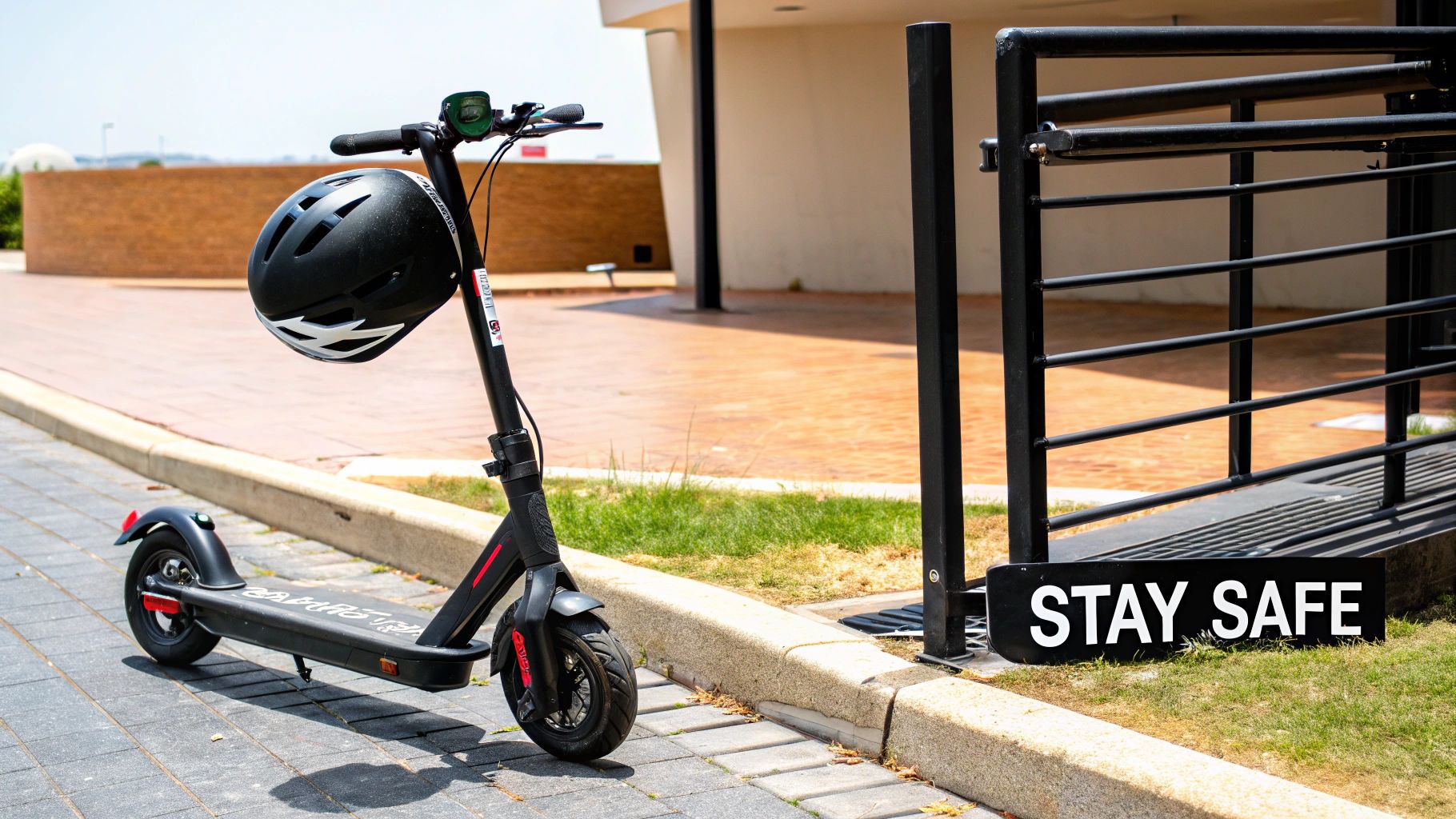
It’s no surprise that personal electric transport is taking off. The global market for e-scooters is booming as people get fed up with traffic jams and pricey fuel. This whole movement is really about finding smarter, greener ways to get around. If you're curious about the industry's growth, Future Market Insights has some interesting data.
So, let's figure out what kind of rider you are.
The Last-Mile Commuter
Do you find yourself constantly jumping from the train to the bus to your final stop? If that’s you, you're what we call a Last-Mile Commuter. For you, portability is king.
- Your Must-Haves: A feather-light design (think under 14 kg / 30 lbs), a folding mechanism you can trust, and a small frame that's a breeze to carry.
- What Really Matters: Don't get distracted by huge batteries or blistering top speeds. You need a scooter that won't feel like you're lugging a boat anchor around the second you walk indoors or hop on public transit.
- Picture This: You ride a couple of miles from your apartment to the station, fold it up, take the train, then unfold it for that last mile to the office. Easy.
The Urban Explorer
Is your scooter your main ride for zipping around town? Then you’re an Urban Explorer, and you need a machine that’s built to last and keep you comfortable.
You're the kind of rider who'll happily trade a little extra weight for a solid, dependable build. Your scooter has to take on bumpy roads, long rides, and whatever else the city throws at it.
You're playing a different game, so your priorities will look a little different:
- Your Must-Haves: A long-range battery (20+ miles), dual suspension to save your back, big 10-inch air-filled tyres, and serious disc brakes for stopping on a dime.
- What Really Matters: Ride quality and battery life are your top concerns. You can’t have a scooter that dies halfway through your day or leaves you feeling every single crack in the pavement.
- Picture This: You ride your scooter for your entire 7-mile commute, use it to grab lunch, and then take it for a spin to check out a new part of town on the weekend. Since it's your main transport, protecting it is a big deal; our guide on how to lock an electric scooter is a must-read.
Got Questions? We've Got Answers
Diving into the world of electric scooters can feel a bit overwhelming, especially with all the specs and models out there. Let's clear up some of the most common questions we get from riders in the US and Australia.
What's the Single Most Important Spec to Look At?
Honestly, for most people, it boils down to real-world battery range. This one number tells you how far you can actually go, and whether a scooter will fit your daily life without giving you range anxiety.
Once you've nailed down the range you need, motor power is the next big thing, especially if your commute involves any hills. And of course, a solid braking system is a must-have for safety—that's non-negotiable. Always, always check out what other riders are saying in reviews to see how the scooter performs in real life, not just on paper.
A killer spec sheet doesn't mean much if the scooter dies halfway through your commute. Focus on range first, then power and safety, and you'll find a ride that truly works for you.
Are E-Scooters Legal to Ride in Public?
This is a big one. The laws for riding privately owned e-scooters vary dramatically depending on where you live. In the United States, regulations are set at the state and city level. Some cities have dedicated bike lanes where scooters are welcome, while others have stricter rules. In Australia, laws also differ by state and territory, with some allowing personal e-scooters on public paths and roads (with speed limits) and others restricting them.
Because the rules are constantly changing, it is absolutely essential to check the current laws with your local department of transport or city council before you ride.
How Much Upkeep Does an E-Scooter Really Need?
Good news—e-scooters are surprisingly low-maintenance. Your main jobs are pretty simple: keep an eye on tyre pressure (if you have air-filled tyres), give your brakes a quick test before rides, and wipe the scooter down to keep it clean.
Taking care of the battery is also key. Try not to let it run completely flat and store it somewhere cool and dry. It's also a good habit to give the bolts and screws a quick check every few weeks to make sure everything is tight and secure. If you do run into a flat, our guide on electric scooter tire replacement makes it a straightforward fix.
Ready to find the perfect ride for your daily commute or weekend adventures? Punk Ride offers a handpicked selection of high-performance electric scooters from leading brands. Explore our collection and find your ideal match today at https://www.punkride.com.
Article created using Outrank




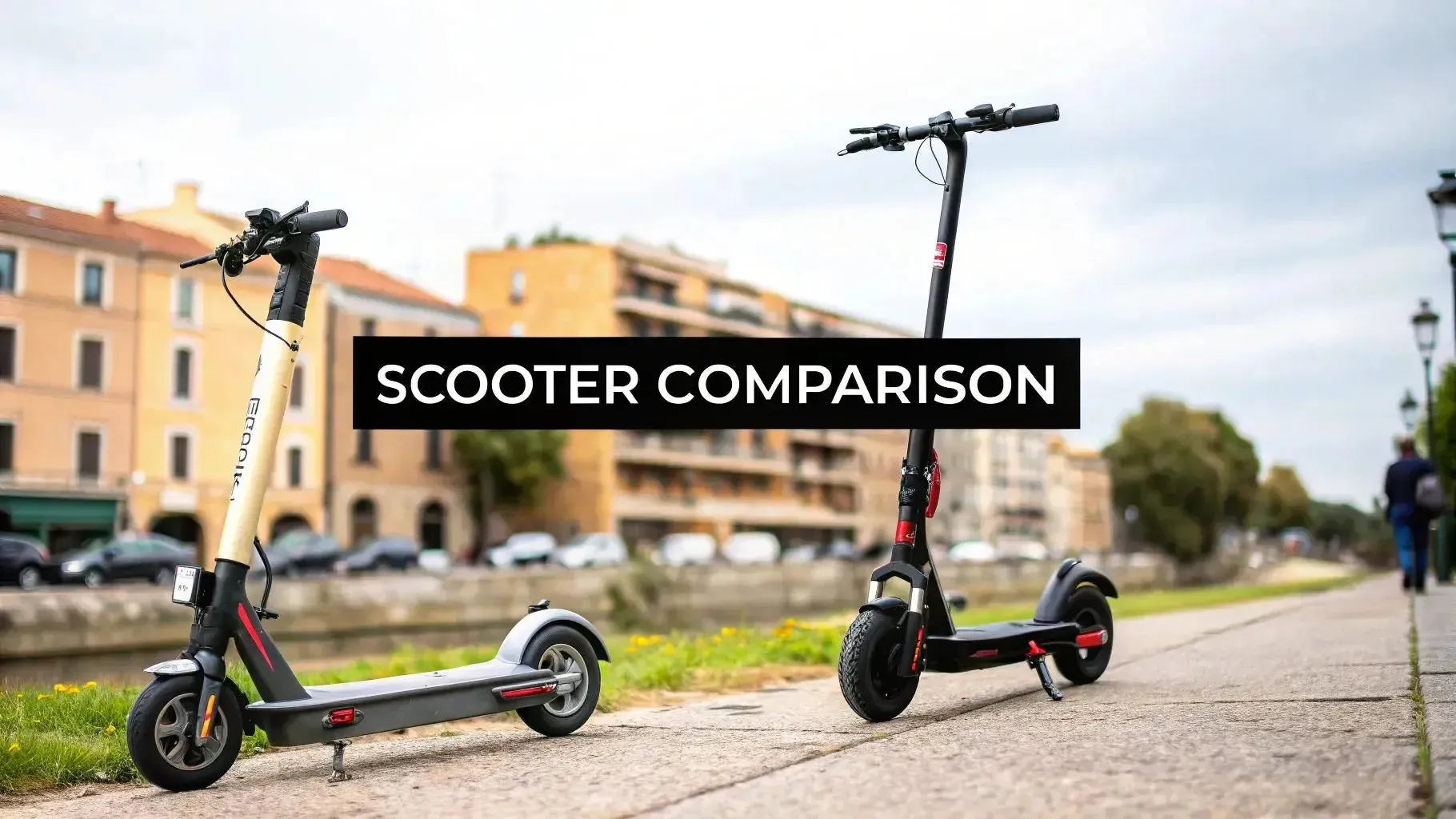
Share:
DIY Electric Scooter Tire Replacement Guide
Your Electric Scooter Buying Guide